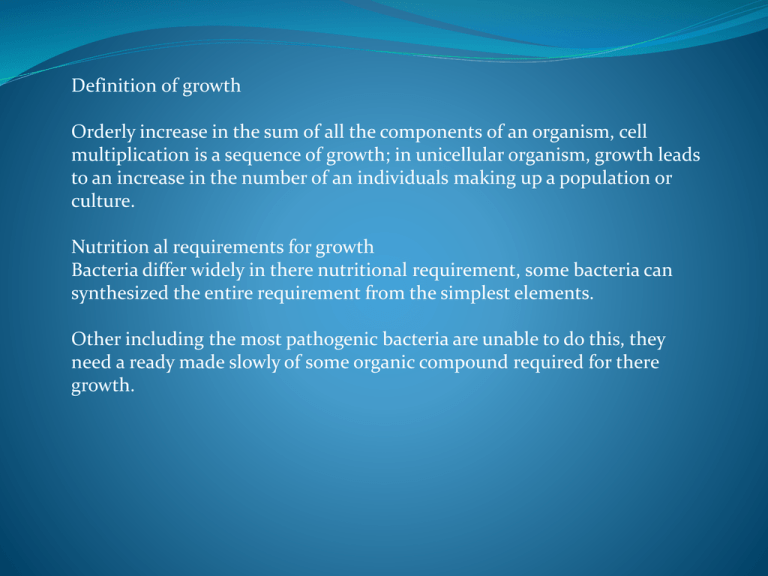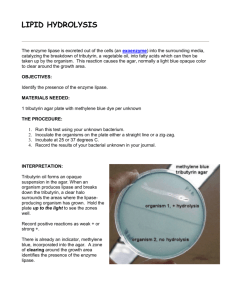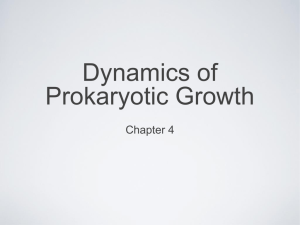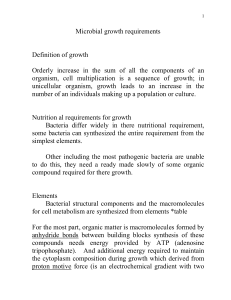bacteriology
advertisement

Definition of growth Orderly increase in the sum of all the components of an organism, cell multiplication is a sequence of growth; in unicellular organism, growth leads to an increase in the number of an individuals making up a population or culture. Nutrition al requirements for growth Bacteria differ widely in there nutritional requirement, some bacteria can synthesized the entire requirement from the simplest elements. Other including the most pathogenic bacteria are unable to do this, they need a ready made slowly of some organic compound required for there growth. Elements Bacterial structural components and the macromolecules for cell metabolism are synthesized from elements *table For the most part, organic matter is macromolecules formed by anhydride bonds between building blocks synthesis of these compounds needs energy provided by ATP (adenosine tripophosphate). And additional energy required to maintain the cytoplasm composition during growth which derived from proton motive force (is an electrochemical gradient with two components a difference in pH (hydrogen ion concentration) and difference in ionic charge Sources of metabolic energy The three major mechanisms for generating metabolic energy are Fermentation Respiration Photosynthesis Fermentation Fermentation is characterized by a substrate phosphorylation, the phosphrelayted intermediated are formed by metabolic rearrangement of a fermentable substrate such as glucose, lactose, or arginin. Respiration is analogous to the coupling of an energy-dependant process to the discharge of a battery Photosynthesis is similar to respiration in that the reduction of an oxidant via a specific series of electron carries establishes a proton motive force. The differences in the two process is that in the photosynthesis the reluctant and oxidant are created photochemical by light energy absorbed pigment in the membrane it can be continues as long as the source of sunlight Nutrition All organism require source of energy, some rely on chemical compounds for there energy and called as Chemotrophes. Other utilize radiant energy (light) are called phototrophs All require source of electrons for there metabolism, by reducing inorganic compounds as electron donors chemolithotrophic Or using organic compounds as electron donors and called chemoorganotrophs Carbon source All organism require carbon in synthesizing cell component. All organism at least small amount of CO2. , those organism using CO2 as a major source know as autorophs. Other require organic compounds as there carbon source and called as heterotrophs Nitrogen source Nitrogen is a major component of proteins and nucleic acid about 10 % of dry weight, nitrogen may be supplied in a number different forms and microorganism vary in their ability to assimilate nitrogen The end products of all pathways for nitrogen assimilation is the most reduced form of the elements ammonium ion (NH4+). Many microorganism possess the ability to assimilate nitrate (NO3-) and nitrite (NO2-) reductively by conversion these ions to ammonia (NH3) The ability to assimilate nitrogen gas reductively by ammonia which his called nitrogen fixation is properties unique to prokaryotes. Most microorganisms can use NH4+ as a source for nitrogen source and many organism posses ability t o produce ammonium ions from amines or amino acids. Many microorganism possess the ability to assimilate nitrate (NO3-) and nitrite (NO2-) reductively by conversion these ions to ammonia (NH3) The ability to assimilate nitrogen gas reductively by ammonia which his called nitrogen fixation is properties unique to prokaryotes. Most microorganisms can use NH4+ as a source for nitrogen source and many organism posses ability t o produce ammonium ions from amines or amino acids. Sulfur source like nitrogen is component of many inorganic cells substances it forms part of several coenzymes most of microorganism can uses sulfate and sulfur source reducing sulfate to level of hydrogen sulfide (h2s) Phosphorus source Phosphate is required as a component of ATP nucleic acids and such as coenzyme NAD NADP and flavines, metabolites lipid, cell wall, capsular polysaccharides. It are always assimilated as a free inorganic phosphate Mineral sources numerous minerals are required for enzyme function as, metal ions K+, Ca+ , Mg+ , Fe+ and others trace elements. Water: all living microorganism require water Growth factor Growth factor is an organic compound (amino acids, puriens and pyramidines, vitamins) which a cell must contain in order to grow but which is unable to synthesize. many micro-organism when provided with the listed above are able to synthesize all of the building blocks for macromolecules ( amino acid, purine, pyrimidine, and pentose) all are metabolic precursors for the nucleic acids then incorporated into DNA, additional cho. precursors for polysaccharides and fatty acids When organism undergo a gene mutation so the chain is broken and no longer there is a products, so the organism must obtain that compound from the environment the compound has become as a growth factor for the organism Nutritional types of bacteria Phototrophs: uses inorganic compounds as thiere source of electrons e.g. chromatium okenii uses H2S S+2e + 2H+ As an electron donor oxidizing it to elemental sulfur Othere uses organic compounds sutch as fatty acid and alcholes as electron donors Chemotrophs that uses inorganic compounds as thiere source of electrons e.g. ammonia as thiere electron sourece obtaining thiere enrgy by oxidizing ammonia to nitrite Autotrophic and hetero trophic Organism can utilize and uses for example charbohydrates and CO2 as thiere source of carbon Obligat parasite those bacteria which canot be cultivated artificially on artifical media Environmental factors affecting growth A suitable growth medium must containes all the nutrient required by the organism to be cultivated * Nutrient The following must be provided Hydrogen donors Carbon source Nitrogen source Minerals sulfur and phosphorus Growth factors Hydrogen ion concentration (pH) Most organism have optimal narrow pHmost of organism are neutrophil grow best at pH 6.0-8.0 Othe acidophoils low pH 3 Alkaliphiles high pH 10.5 Temperature Different microbial species vary wiedly in their optimal temperature ranges for growth: Psychrophilic forms grows best at low tempratues (15-20 oC) Mesophilic grow best at (30-37 oC)* Thermophilic gorw at (50-60 oC) Heat shock response: when organisms exposed to a sudden rise in temperature above growth optimal, theses proteins appears to be unusually heat resistant to stabilize the heat-sesitve proteins Cold shock; a number of compound protects cells from either freezing or cold shock (glycerol ad dimethylsulphoxide are mist common used. Aeration Many of organism are obligate aerobic others are facultative aerobic and anaerobic. The natural products of aerobic metabolism are the reactive compound hydrogen peroxide (H2O2), And superperoxide (O2) These products can damage any biological macromolecules 2O2 + 2H O2 + H2O2 Many aerobes and anaerobic are protected from these products by the presences of superperoxied dismutase enzyme that catalysis the reaction (Catalase enz). 2H2O2 2H2O2+O2 Some fermentation organism doesn’t contains either of enz. Oxygen is not reduced therefore there will be no products For anaerobic organism have a considerable tolerance to oxygen as a result of their ability to produce high level of an enzy (NADH oxidase) that reduces oxygen to water NADH + H +1/2 O2 NAD + H2O Hydrogen peroxide owes much of its toxicity to the damage it causes to DNA Obligates anaerobic present a problem in oxygen exclusion using reducing agent such as thioglycolate can be added to liquid medium or the medium sealed with a layer of petrolatum and paraffin Ionic strength and osmotic pressure Organism require high salt concentration know as hallophilic Those requiring high osmotic pressure are called osmophilic Most of bacteria are able to tolerate external osmotic pressure and ionic strength because of their ability to regulate internal osmolality and ion concentration Culturing of microorganism Culture teachnique used to isolate pathogens in pure culture so that they can be identified , and ifindicated , testedfor thiere sensitivity (Susceptibility to antimicrobials) Most of bacteria can be cultured artificially providing: The culture medium contains the required nutrients in the correct amounts and the osmotic pressure and pH of the medium also correct The microorganism are incubated in atmosphere and temperature most suited to there metabolism Microbial growth requirement Approximately 80% of the living weight of bacterial cell is water and the rest is of dry weight 2-5% is phosphorus , minerals oxygen and hydrogen inorganic compounds So the media should contains water, source of nitrogen, carbon, minerals , and essential vitamins. Other substances may be included according to the species requirements. Common ingredient of culture media Peptone: This is a general term for the water soluble products obtained from the breakdown (hydrolysis) of animal or plant proteins. The proteins are commonly those from meat, milk, and soya bean meal. They are hydrolyzed by acids or by enzymes such as pepsin, trypsin, and papain. The products are free amino acids, peptides (polymers of amino acids) and proteoses (large size peptides). All forms of peptone are not coagulated by heat. Peptone provides nitrogen for growing microor-ganisms. Plant proteins such as soya peptone also provide carbohydrates, and most peptones contain nucleic acid fractions, minerals and vitamins. *Peptone powder should be light in color, dry, and have a neutral pH. The concentration and form of peptone used depend on the uses of individual culture media, for example peptones with a high tryptophan content are used in indole testing media, proteose peptone is used in media for bacterial toxin production, tryptose in enriched media, and tryptone which is particularly rich in amino acids is added to several media including blood culture media. Meat extracts Beef extract such as Lab Lemco provides organisms with a further supply of amino acids, and also with essential growth vitamins and mineral salts including phosphates and sulphates. It is an ingredient of many culture media including nutrient agar and nutrient broth. Trypsin digested meat extracts are also used Yeast extract This is contained in many culture media as a bacterial growth stimulant, for example in xylose lysine deoxycholate (XLD) medium, modified New York City (MNYC) medium, and thiosulphate citrate bile salt sucrose (TCBS) medium. Mineral salts For cell growth, sulphates are required as sources of sulphur and phosphates as sources of phosphorous. Culture media should also contain traces of magnesium, potassium, iron, calcium and other elements which are required for bacterial enzyme activity. Sodium chloride is also an essential ingredient of most culture media. Carbohydrates Simple or complex sugars are added to many culture media to provide bacteria with sources of carbon and energy. Carbohydrates are also added to media to assist in the differentiation of bacteria, for example lactose is added to MacConkey agar and deoxycholate citrate agar to differentiate enterobacteria, and sucrose to TCBS agar to differentiate Vibrio species. Fermentation of the sugar with acid production is detected by a change in colour of the indicator. Fermentation is often accompanied by the production of gas (carbon dioxide and hydrogen). Agar This is an inert polysaccharide extract obtained from a variety of redpurple seaweeds (rhodophyceae) which form the agarophyte group of marine algae. It consists of two main polysaccharides, agarose (70-75%) and agaropectin (20-25%). Agar is used to solidify culture media because of its high gelling strength and its setting temperature of 32-39"C and melting temperature of 90-95'C. Most agars used in bacteriological work produce a firm gel at a conci--ntration of 1.5% w/v. The low gelling temperature allows heat-sensitive nutrients such as whole blood to be added safely at 45-50 OC. At a concentration of 0.4-0.5% w/v, agar is added to transport media such as Amies medium to give a semisolid gel. Besides being used to solidify culture media, agar also provides microorganisms with calcium and other organic ions. Water This is essential for the growth of all microorganisms. It must be free from any chemicals which inhibit bacterial growth. Deionized or distilled water must be used in the preparation of culture media if the local water supply has a high mineral content. TYPES AND SELECTION OF CULTURE MEDIA The main types of culture media are: Basic Enriched and enrichment Selective Differential Transport Basic media These are simple media such as nutrient agar and nutrient broth that will support the growth of microorganisms that do not have special nutritional requirements. , They are often used in the preparation of enriched media, to maintain stock cultures of control strains of bacteria, and for subculturing pathogens from differential or selective media prior to performing biochemical and serological identification tests. Enriched media These are media that are enriched with whole blood, lyzed blood, serum, extra peptones, special extracts, or vitamins to support the growth of pathogens that require additional nutrients or growth stimulants. Enriched media are required for the culture of Haemophilus influenzae, pathogenic Neisseria, and several Streptococcus species. Blood agar and tryptone soya media are used to produce a better and more rapid growth of a wide range of pathogens. Note: The term enrichment is used to describe a fluid medium that increases the numbers of a pathogen by containing enrichments, and, or substances that discourage the multiplication of unwanted bacteria. For example, selenite F broth is used as an enrichment medium for salmonellae in faeces or urine prior to subculturing on xylose lysine deoxycholate (XLD) agar or other enteric selective medium. Selective media These are media which contain substances that prevent or slow down the growth of microorganisms other than the pathogens for which the media are intended. For example, XLD agar selects for salmonellae and shigellae by containing bile salts that inhibit the growth of many faecal commensals. In recent years, antimicrobials have become increasingly used as selective agents in culture media. Examples of antimicrobial selective media include modified New York City (MNYQ medium for isolating Neisseria gonorrhoeae from urogenital specimens, and Butzler medium for isolating Campylobacter species from faeces. Selective media are available for isolating most of the important pathogens. Differential (indicator) media These are media to which indicators, dyes, or other substances are added to differentiate microorganisms, for example TCBS agar contains the indicator bromothymol. blue which differentiates sucrose fermenting from nonsucrose fermenting Vibrio species. Most, but not all differential media distinguish between bacteria by an indicator which changes colour when acid is produced following carbohydrate fermentation. Blood agar, however, can also be described as a differential medium when it differentiates haemolytic from non-haemolytic bacteria. As shown in the Chart on p. 43-44, many culture media are both differential and selective such as TCBS agar, MacConkey agar, XLD agar and DCA. Enriched media may also be made selective and, or, differential. For example, crystal violet blood agar is an enriched, selective, and differential medium for Streptococcus pyogenes (Group A Streptococcus). Transport media These are mostly semisolid media that contain ingredients to prevent the overgrowth of commensals and ensure the survival of aerobic and anaerobic pathogens when specimens cannot be cultured soon after collection. Their use is particularly important when transporting microbiological specimens from health centres to the district microbiology laboratory. Choice of culture media The selection of culture media to use in district microbiology laboratories will depend on: - The major pathogens to be isolated, their growth requirements, and the features by which they are recognized. - Whether the specimens being cultured are from sterile sites or from sites having a normal microbial flora. Although a selective medium is usually more expensive than a non-selective one, the use of a selective medium often avoids subculturing, isolates a pathogen more quickly, and makes it easier to differentiate and interpret bacterial growth especially by laboratory staff with limited experience. - The cost, availability, and stability of different media in tropical and developing countries. - The training and experience of laboratory staff in preparing, using, and controlling culture media. Note: Information regarding the preparation and control of culture media can be found in 48: 1. SOLID, SEMISOLID AND FLUID CULTURE MEDIA Culture media can be used in three forms: Solid Semisolid Fluid Solid culture media This form of media is used mainly in petri dishes as plate cultures. It can also be used in bottles or tubes as stab (deep) or slope cultures. The inoculation of plates, slopes, and deeps When grown on solid media, microorganisms multiply to form visible colonies. Colonial appearances and any changes in the surrounding medium help to identify bacteria and differentiate commensals from pathogens. Some cultures also have a distinctive smell, for example those of Proteus and Pseudomonas aeruginosa. Colonial appearances Bacterial colonies should be examined in a good light. A low power magnifying lens is required to see morphological details. When viewed from above, colonies may appear round, irregular, crenated, or branching. They may be transparent or opaque and their surface may be smooth or rough, dull or shiny. The colonies of capsulated species appear mucoid. Mature colonies of pneumococci have a ringed appearance. When viewed from the side, colonies may appear flat or raised in varying degrees sometimes with bevelled edges or with a central elevation or depression. When touched with a wire loop, some colonies are soft and easily emulsified such as Staphylococcus aureus, whereas others are difficult to break up such as Streptococcus pyogenes. The colour of colonies also helps to identify bacteria, especially when using differential media containing indicators. others are difficult to break up such as Streptococcus pyogenes. The colour of colonies also helps to identify bacteria, especially when using differential media containing indicators. Medium changes These include haemolytic reactions, pigment production, colour changes surrounding carbohydrate fermenting colonies, and blackening due to hydrogen sulphide production. Am example of a pigment-forming organism is Pseudomonas aeruginosa which produces a yellow-green colour in media such as blood agar and MacConkey agar. examples of carbohydrate fermenting bacteria that produce color changes in media include sucrose fermenting Vibrio cholerae that gives a yellow colour in TCBS agar, lactose fermenting Clostridium perfringens that produces a pinkred color in lactose egg yolk milk agar, and manitol fermenting Staphylococcus aureus that gives a yellow color in mannitol salt agar. Blackening in the medium due to hydrogen sulphide production is seen with many salmonellae cultured in Kligler iron agar. Haemolytic reactions in blood agar are seen ,%ith beta-haemolytic streptococci and alphahaemolytic pneumococci. Fluid culture media The growth and multiplication of bacteria in a fluid medium is usually described in four stages, or phases, as follows: Lag phase, during which the organisms adjust to their new surroundings. - Logarithmic phase, during which the bacteria reproduce rapidly. In multiplying, the organisms use up the food substances in the medium and introduce into it toxic products of metabolism. Stationary phase, during which there is no further increase in the concentration of living bacteria in the medium. There is a balance reached between the number of bacteria dying and those being produced. Decline phase, during which the concentration - of living organisms is reduced as the number of dying bacto,'fia out-number the living bacteria in the medium. The inoculation of fluid culture media is described in 35:4. Growth is shown by a turbidity in the medium. A surface growth is shown by some organisms, for example vibrios in alkaline peptone water. Fluid media are used mainly as enrichment media, biochemical testing media, and blood culture media (see Chart at the end of this subunit) Semisolid culture media This form of medium is prepared by adding a small amount of agar (0.4-0.5% w/v) to a fluid medium. Semisolid media are used mainly as transport media and for motility testing. Examples are given in the following Chart:







